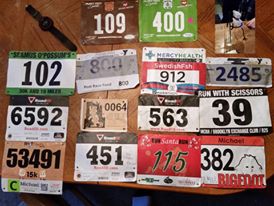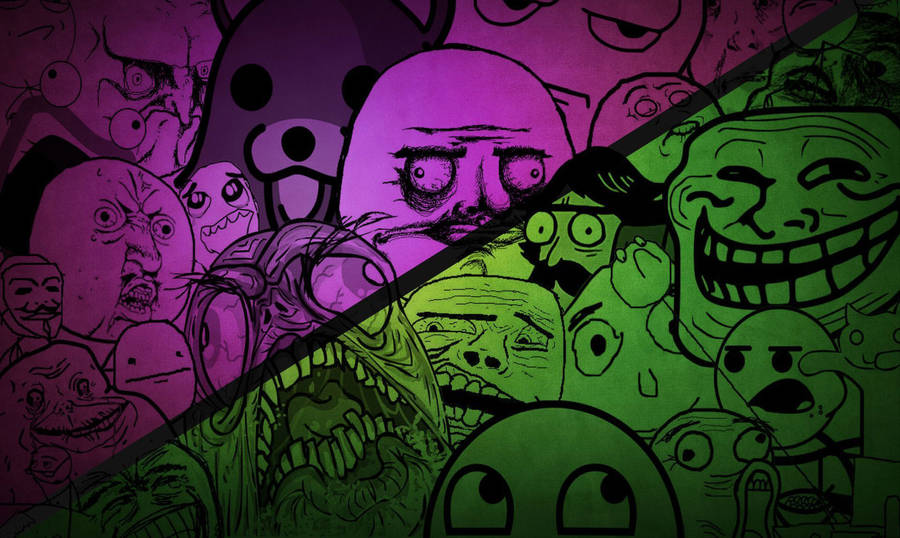People kept telling me that I ran a lot this year. Like a lot a lot. Upon reflecting, it is probably an accurate statement. I completed 16 different events this year: Rocks and Roots 10k, Brokeman’s Winter Warm up half marathon, Rocks and Roots 20k, Possum 30k, The ORRRC Xenia ½ marathon, Glass City Toledo Marathon, ORRRC Tie Dye 32 miler, Columbus Zoo 5k, Brokemans Wild Things 4 miler, Not Your Momma’s 50 km, Running with Scissors double marathon, Hot Chocolate 15km, New Albany 4 miler, Run Santa Run 5k, Big Foot 10 miler, and the Yeti Run.
Looking at that list I’m pretty much in awe - It was about 3 years ago that I ran my second half marathon and swore I would never run that distance again. It was just over a year ago I finished my first marathon. I found a picture of my 2014 bibs (EDIT: it was actually my bibs from 2013 AND 2014) on facebook and in the comments section I was ecstatic that it had four 5k bibs, a 10k bib and 2 half marathon bibs. Now I have run a marathon distance or more six different times (four of those times in 2016.)
Oddly enough I became friends with Erika in 2014. Pure coincidence I’m sure. Sidenote, Erika is running the Pistol Ultra 100 miler on New Years eve/day - so proud of her! You can read about her adventure here.
Still, the year was not ‘perfect.’ I had two did not finish results (DNF) this year: The first was at the January Rocks and Roots which was supposed to be a 20k but due to the fact I could not feel my feet (literally) after the first 10k, I chose to stop. The second was the Scissors double marathon where I “only”ran moved forward 41.1 (66km) of the 52.4 miles. You can read more about that here.
However, I also fell in love with pacing this year, leading the 11 minute pace group during the Columbus Hot Chocolate 15k. It was great helping people achieve their goals since so many people had helped me achieve mine over the past year. Case in point, I ended the year with my fastest 5k ever thanks to my great friends Becky and Erika. It would have been an even faster time if I could have kept up with them past mile 2.5.
All in all I have logged over 1360 miles (about 2200 km) of running this year. For some perspective, that is about the distance from Cleveland to Denver. Looking forward, I have a number of activities and events in 2017. So far I have at least three half marathons, one full marathon, and two 50 kilometer runs on my calendar by the first week of June. Yes I said at least.
A big thank you to all of my friends and family that supported me with encouragement, candy, a sarcastic comment, or all of the above. My wife and two daughters are just brilliant. They push me, encourage me, cheer me on, and fully support me in all of this. I truly would not be able to do this without them.
I love all of my running buddies and I'm proud of every mile we logged together! I will need all of your support, encouragement, and more in the coming weeks!
I’m looking to share many more miles and stories with all of you in 2017!
Happy Running :)
They were all my favorite. Especially Yeti.
Looking at that list I’m pretty much in awe - It was about 3 years ago that I ran my second half marathon and swore I would never run that distance again. It was just over a year ago I finished my first marathon. I found a picture of my 2014 bibs (EDIT: it was actually my bibs from 2013 AND 2014) on facebook and in the comments section I was ecstatic that it had four 5k bibs, a 10k bib and 2 half marathon bibs. Now I have run a marathon distance or more six different times (four of those times in 2016.)
Not Yo Momma's 50k - the most difficult 50k I've run to date.
Still, the year was not ‘perfect.’ I had two did not finish results (DNF) this year: The first was at the January Rocks and Roots which was supposed to be a 20k but due to the fact I could not feel my feet (literally) after the first 10k, I chose to stop. The second was the Scissors double marathon where I “only”
I still gave myself a present.
However, I also fell in love with pacing this year, leading the 11 minute pace group during the Columbus Hot Chocolate 15k. It was great helping people achieve their goals since so many people had helped me achieve mine over the past year. Case in point, I ended the year with my fastest 5k ever thanks to my great friends Becky and Erika. It would have been an even faster time if I could have kept up with them past mile 2.5.
All in all I have logged over 1360 miles (about 2200 km) of running this year. For some perspective, that is about the distance from Cleveland to Denver. Looking forward, I have a number of activities and events in 2017. So far I have at least three half marathons, one full marathon, and two 50 kilometer runs on my calendar by the first week of June. Yes I said at least.
Here we go again.
I love all of my running buddies and I'm proud of every mile we logged together! I will need all of your support, encouragement, and more in the coming weeks!
I’m looking to share many more miles and stories with all of you in 2017!
Happy Running :)




























